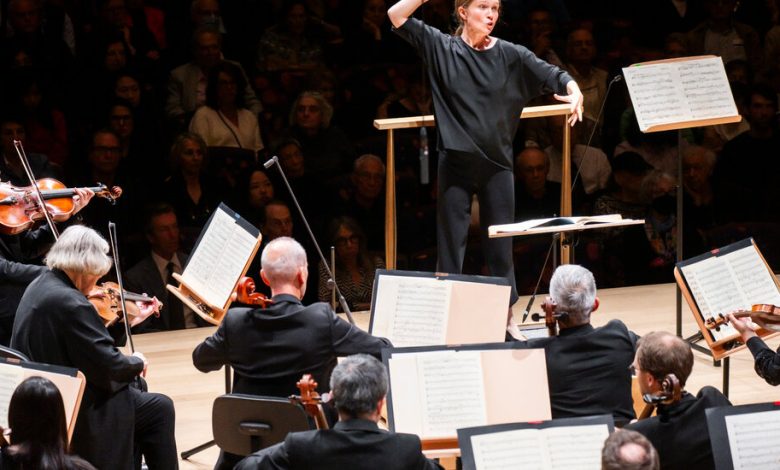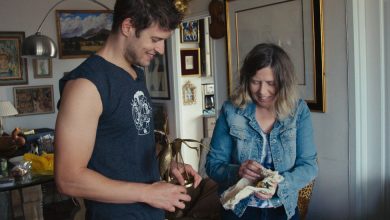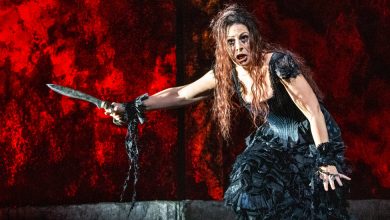In Her Debut, a Conductor Gets the Philharmonic (and Geffen Hall)

Welcome to Season 2 of the New York Philharmonic in its renovated David Geffen Hall. If there is one story line that has carried over from Season 1, it’s the sound.
The new Geffen Hall’s acoustics are clearer, if chillier than before. Because every detail in the orchestral playing is more easily audible, so too is every choice about balance — making the hall a tough proving ground for conductors. Guests can find themselves neatly sifted into one of two categories: those who intuitively grasp how to steer the Philharmonic in this space, and those who don’t.
Mirga Gražinytė-Tyla, who made her Philharmonic debut on Wednesday night, gets it.
This Lithuanian conductor led her first program at Geffen with assurance across varied styles — a feat that hasn’t been easily matched by some of her peers in the hall. Sometimes, modern or contemporary works can sound admirably chiseled, while 19th-century ones stint on warmth, and thus charm.
The evening, which the Philharmonic dedicated “to those impacted by the conflict and humanitarian crisis in Israel and the Gaza Strip,” included music from a living composer, Raminta Serksnytė’s “De Profundis”; a repertory war horse, Robert Schumann’s Piano Concerto; and a rarity from Sibelius, excerpts from the “Lemminkainen Suite.” But no era or style felt shortchanged on Wednesday. The strings in particular were hard-edged when they needed to be (in the Serksnyte), then icy and glinting (in the Sibelius).
Schumann’s concerto was the lush highlight of the program. In the first movement, low strings and percussion had their forceful say, as expected. But subtler delicacies were plentiful: Winds collaborated on heavenly blends; trumpet notes came across as peppery without blaring; violins swooned alongside the soloist.
That soloist was Daniil Trifonov, an artist constitutionally incapable of a wan take. He offered a personal, thrilling, at times idiosyncratic approach to Schumann’s famed binary of contrasting alter egos: Florestan and Eusebius. There was plenty of thrusting force in opening chords, representing Florestan and played with abandon reminiscent of Martha Argerich’s style in this concerto. Elsewhere, he delivered winning grace, embodying the moods of Eusebius.
But Trifonov did more than run between those bases — he brought them into extended, unexpected dialogue. In quiet stretches, he practically halted his momentum, putting confrontational, 20th-century concepts of space and negation into the flow of the beautiful writing. Likewise, amid fierce tutti passages for piano and orchestra, the fine mechanisms of his playing reached a state of meditative delirium normally associated with Schumann’s dreamy, Eusebian side.
Gražinytė-Tyla was alert to each new blend, and matched the orchestra to Trifonov’s prismatic turns. At the close of the first movement, she seemed to use the quick cutoff of Geffen’s acoustic to underline new rhythmic patterning in the score, helping familiar music feel sparkling and alive.
Serksnyte’s “De Profundis,” an early work from 1998, opened with motivic boldness and some quickly roving ideas about rhythmic fragmentation, but spun its wheels a bit before a rousing-then-hissing finale. And the three sections of Sibelius’s suite had charm — including a mellow English horn solo from Ryan Roberts in “The Swan of Tuonela” — though it’s hardly material from this composer’s top drawer.
And yet the orchestra, heard in its best form on Wednesday, found joy and merit throughout the program. For Gražinytė-Tyla, this was the kind of debut that immediately has you thinking about her future with the Philharmonic. She’s famously happy with freelancing. And, well, New York is a freelancer’s kind of town.
New York Philharmonic
This program continues through Saturday at David Geffen Hall, Manhattan; nyphil.org.





